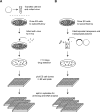Gene trap mutagenesis in the mouse
- PMID: 20699145
- PMCID: PMC5659187
- DOI: 10.1016/S0076-6879(10)77013-0
Gene trap mutagenesis in the mouse
Abstract
Gene trapping in mouse embryonic stem (ES) cells is an efficient method for the mutagenesis of the mammalian genome. Insertion of a gene trap vector disrupts gene function, reports gene expression, and provides a convenient tag for the identification of the insertion site. The trap vector can be delivered to ES cells by electroporation of a plasmid, by retroviral infection, or by transposon-mediated insertion. Recent developments in trapping technology involve the utilization of site-specific recombination sites, which allow the induced modification of trap alleles in vitro and in vivo. Gene trapping strategies have also been successfully developed to screen for genes that are acting in specific biological pathways. In this chapter, we review different applications of gene trapping, and we provide detailed experimental protocols for gene trapping in ES cells by retroviral and transposon gene trap vectors.
2010 Elsevier Inc. All rights reserved.
Figures



Similar articles
-
A wider context for gene trap mutagenesis.Methods Enzymol. 2010;477:271-95. doi: 10.1016/S0076-6879(10)77014-2. Methods Enzymol. 2010. PMID: 20699146
-
Diphtheria toxin-mediated transposon-driven poly (A)-trapping efficiently disrupts transcriptionally silent genes in embryonic stem cells.Genesis. 2020 Sep;58(9):e23386. doi: 10.1002/dvg.23386. Epub 2020 Jul 9. Genesis. 2020. PMID: 32645254
-
Sleeping beauty transposon-mediated poly(A)-trapping and insertion mutagenesis in mouse embryonic stem cells.Environ Mol Mutagen. 2018 Oct;59(8):687-697. doi: 10.1002/em.22234. Epub 2018 Oct 2. Environ Mol Mutagen. 2018. PMID: 30280432
-
Gene trapping techniques and current progress.Yi Chuan Xue Bao. 2006 Mar;33(3):189-98. doi: 10.1016/S0379-4172(06)60039-5. Yi Chuan Xue Bao. 2006. PMID: 16553206 Review.
-
Gene-trap mutagenesis: past, present and beyond.Nat Rev Genet. 2001 Oct;2(10):756-68. doi: 10.1038/35093548. Nat Rev Genet. 2001. PMID: 11584292 Review.
Cited by
-
Mouse lipin-1 and lipin-2 cooperate to maintain glycerolipid homeostasis in liver and aging cerebellum.Proc Natl Acad Sci U S A. 2012 Sep 11;109(37):E2486-95. doi: 10.1073/pnas.1205221109. Epub 2012 Aug 20. Proc Natl Acad Sci U S A. 2012. PMID: 22908270 Free PMC article.
-
Cre/lox generation of a novel whole-body Kiss1r KO mouse line recapitulates a hypogonadal, obese, and metabolically-impaired phenotype.Mol Cell Endocrinol. 2019 Dec 1;498:110559. doi: 10.1016/j.mce.2019.110559. Epub 2019 Aug 20. Mol Cell Endocrinol. 2019. PMID: 31442544 Free PMC article.
-
Beyond classic editing: innovative CRISPR approaches for functional studies of long non-coding RNA.Biol Methods Protoc. 2019 Dec 13;4(1):bpz017. doi: 10.1093/biomethods/bpz017. eCollection 2019. Biol Methods Protoc. 2019. PMID: 32161809 Free PMC article. Review.
-
Telomerase reverse transcriptase gene knock-in unleashes enhanced longevity and accelerated damage repair in mice.Aging Cell. 2025 Apr;24(4):e14445. doi: 10.1111/acel.14445. Epub 2024 Dec 11. Aging Cell. 2025. PMID: 39660787 Free PMC article.
-
Stabilization of Cyclin-Dependent Kinase 4 by Methionyl-tRNA Synthetase in p16INK4a-Negative Cancer.ACS Pharmacol Transl Sci. 2018 Apr 24;1(1):21-31. doi: 10.1021/acsptsci.8b00001. eCollection 2018 Sep 14. ACS Pharmacol Transl Sci. 2018. PMID: 32219202 Free PMC article.
References
-
- Anastassiadis K, Fu J, Patsch C, Hu S, Weidlich S, Duerschke K, Buchholz F, Edenhofer F, Stewart AF. Dre recombinase, like Cre, is a highly efficient site-specific recombinase in E. coli, mammalian cells and mice. Dis Model Mech. 2009;2:508–15. - PubMed
-
- Araki K, Imaizumi T, Sekimoto T, Yoshinobu K, Yoshimuta J, Akizuki M, Miura K, Araki M, Yamamura K. Exchangeable gene trap using the Cre/mutated lox system. Cell Mol Biol (Noisy-le-grand) 1999;45:737–50. - PubMed
-
- Baer A, Bode J. Coping with kinetic and thermodynamic barriers: RMCE, an efficient strategy for the targeted integration of transgenes. Curr Opin Biotechnol. 2001;12:473–80. - PubMed
-
- Bonaldo P, Chowdhury K, Stoykova A, Torres M, Gruss P. Efficient gene trap screening for novel developmental genes using IRES beta geo vector and in vitro preselection. Exp Cell Res. 1998;244:125–36. - PubMed
-
- Buchholz F, Angrand PO, Stewart AF. Improved properties of FLP recombinase evolved by cycling mutagenesis. Nat Biotechnol. 1998;16:657–62. - PubMed
Publication types
MeSH terms
Substances
Grants and funding
LinkOut - more resources
Full Text Sources

